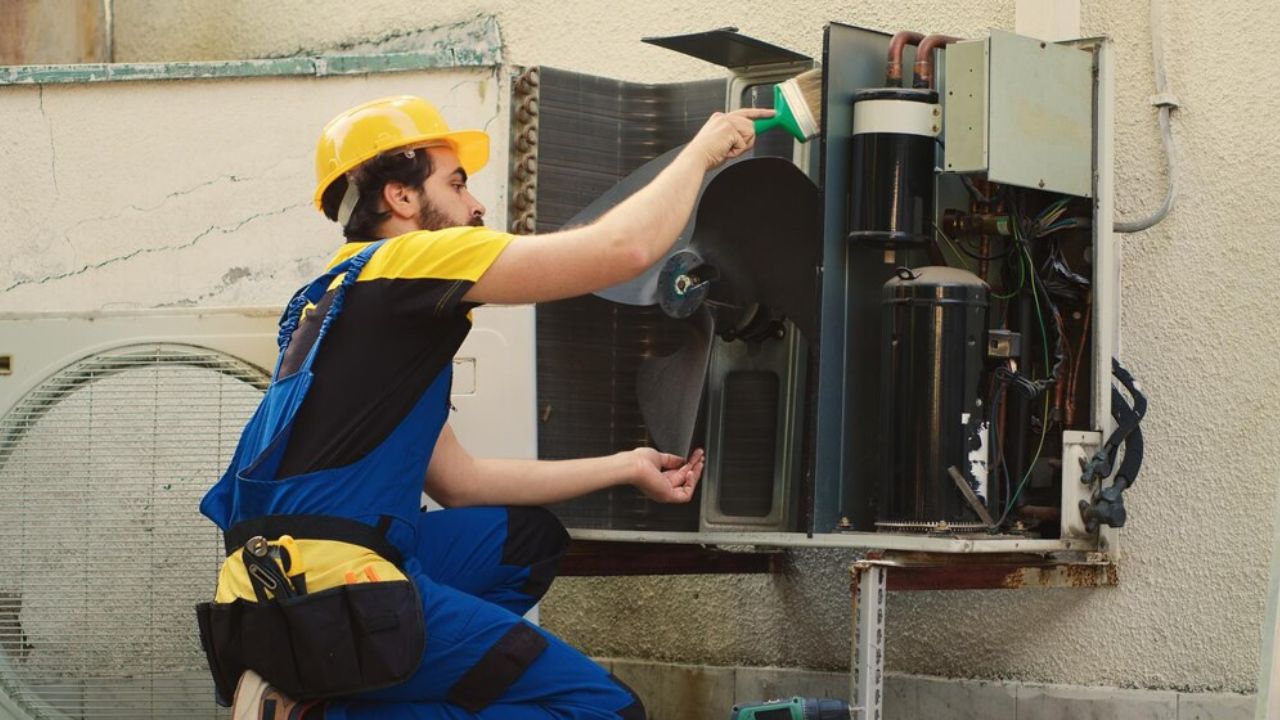HOME
49.2.5 A/C Belt Replacement: A Comprehensive Guide

When the temperature rises and the scorching heat becomes unbearable, your car’s air conditioning (A/C) system is your best friend. But what happens when the A/C belt, a crucial component of this system, starts showing signs of wear and tear? If you’re a vehicle enthusiast or a DIYer, understanding how to replace the 49.2.5 A/C belt can save you time and money. This comprehensive guide will walk you through the process, whether you’re a seasoned mechanic or a curious beginner eager to learn.
Understanding the A/C Belt and Its Importance
The 49.2.5 A/C Belt Replacement is a vital part of your vehicle’s air conditioning system, responsible for driving the compressor. This belt ensures that refrigerant circulates properly, maintaining a cool and comfortable environment inside your car. When this belt begins to deteriorate, you might notice reduced cooling efficiency, strange noises, or visible cracks on the belt itself, all of which indicate it’s time for a replacement.
A damaged A/C belt not only affects your comfort but also poses a risk to other engine components. If it snaps, it could damage adjacent parts, leading to costly repairs. Understanding the belt’s function helps underline the importance of timely replacement, ensuring the longevity of your vehicle’s A/C system.
Signs Your A/C Belt Needs Replacement
Recognizing the early signs of a failing A/C belt can prevent further damage and maintain the efficiency of your car’s cooling system. Listen for squealing noises when you start the engine or turn on the A/C. These noises often indicate that the belt is slipping or misaligned. Another sign is if the A/C fails to cool the car adequately, suggesting that the belt isn’t driving the compressor properly.
Visual inspection is an easy way to check the belt’s condition. Look for cracks, fraying, or glazing on the belt’s surface. If you notice any of these signs, it’s time to consider a replacement. Addressing the issue promptly can prevent a complete breakdown of your A/C system and avoid unexpected repair costs.
Tools You Need for A/C Belt Replacement
Before you start the replacement process, gather the necessary tools to ensure a smooth and efficient experience. A basic toolkit is essential, including a socket set, wrenches, and screwdrivers. Having a serpentine belt tool can make the job easier, allowing you to loosen the tensioner with minimal effort.
Safety gear is just as important. Equip yourself with safety glasses and gloves to protect against any accidents during the replacement process. A flashlight can be invaluable for illuminating the engine bay, ensuring you can see the belt and surrounding components clearly.
Preparing Your Vehicle for A/C Belt Replacement
Start by parking your vehicle on a level surface and engaging the parking brake. Ensure the engine is off and cool to prevent accidents or injuries. Open the hood and disconnect the battery to eliminate the risk of electrical shock while working on the vehicle.
Gather all your tools and lay them out within reach. Having everything you need at hand will streamline the process, allowing you to focus on replacing the belt without unnecessary interruptions. This preparation sets the stage for a successful replacement, minimizing hassle and maximizing safety.
Removing the Old A/C Belt
Begin by locating the serpentine belt tensioner. This component maintains the tension on the belt and will need to be loosened to remove the old belt. Use your serpentine belt tool or a suitable wrench to rotate the tensioner counterclockwise, releasing the tension on the belt.
With the tension relieved, carefully slide the old belt off the pulleys. Take note of the belt’s routing across various pulleys, as you’ll need to replicate this pattern when installing the new belt. Removing the old belt is a straightforward process, laying the groundwork for the next steps in this replacement guide.
Choosing the Right Replacement Belt
Selecting the correct replacement belt is crucial for optimal performance. Refer to your vehicle’s manual or check the existing belt for size specifications. Ensure you purchase a quality belt from a reputable manufacturer to avoid premature wear and potential failures.
When buying a new belt, consider the material and construction. High-quality belts are often made from durable materials like EPDM rubber, designed to withstand heat and stress. Investing in a reliable belt ensures the longevity of your A/C system and contributes to a smoother driving experience.
Installing the New A/C Belt
With the old belt removed and the correct replacement in hand, it’s time to install the new A/C belt. Begin by routing the belt around the pulleys, following the pattern you noted earlier. Double-check the alignment to prevent misplacement, which can lead to uneven wear or slippage.
Once the belt is in position, use the serpentine belt tool to apply tension by rotating the tensioner clockwise. Ensure the belt is snug but not overly tight, as excessive tension can damage both the belt and the pulleys. Proper installation is key to maintaining the efficiency and reliability of your A/C system.
Testing the A/C System
After installing the new belt, it’s crucial to test the A/C system to ensure everything is functioning as expected. Reconnect the battery and start the engine, listening for any unusual noises that might indicate a problem. Turn on the A/C and check for proper cooling.
Inspect the belt visually while the engine is running, verifying that it’s running smoothly across the pulleys. If any issues arise, revisit the installation process to correct any errors. A thorough test confirms the success of your replacement, ensuring your A/C system is ready to tackle the heat.
Tips for Maintaining Your New A/C Belt
Regular maintenance can extend the life of your new A/C belt, ensuring consistent performance from your vehicle’s cooling system. Periodically inspect the belt for signs of wear or damage, addressing issues promptly to prevent breakdowns.
Keep your engine bay clean to reduce the accumulation of dirt and debris, which can accelerate wear. Additionally, consider consulting your vehicle’s maintenance schedule for specific recommendations on belt inspections and replacements, aligning with manufacturer guidelines for optimal care.
Common Mistakes to Avoid During Replacement
Even seasoned DIYers can make mistakes during A/C belt replacement. Avoid over-tightening the belt, as excessive tension can lead to premature wear or damage to the pulleys. Ensure the belt is routed correctly to prevent slippage or misalignment.
Neglecting to inspect other components like the tensioner or pulleys can lead to future problems. Take the opportunity to check these parts for wear or damage, replacing them if necessary. By avoiding these common pitfalls, you can ensure a successful replacement and prolong the life of your A/C system.
When to Seek Professional Help
While replacing an A/C belt can be a straightforward task, some situations warrant professional assistance. If you encounter complex issues like seized pulleys or stripped bolts, consulting a professional mechanic can prevent further damage.
Additionally, if you’re unsure about any step in the process, seeking expert help can provide peace of mind and ensure the job is done correctly. Remember, there’s no shame in reaching out for assistance, especially when it comes to maintaining your vehicle’s performance and safety.
The Benefits of Regular A/C Maintenance
Regular maintenance of your vehicle’s A/C system offers numerous benefits beyond just comfort. It can improve fuel efficiency, as a well-functioning A/C system doesn’t overtax the engine. Additionally, routine checks can prevent costly repairs by identifying and addressing minor issues before they escalate.
Maintaining your A/C system also enhances your driving experience, ensuring a comfortable environment regardless of external temperatures. By committing to regular inspections and timely replacements, you can enjoy a reliable and efficient air conditioning system year-round.
Conclusion
Replacing the A/C belt may seem daunting, but with the right knowledge and tools, it’s a task well within the reach of most car enthusiasts. Understanding the importance of this component and following a systematic approach ensures a successful replacement, preserving the performance of your vehicle’s A/C system.
Don’t wait for discomfort or damage to dictate your actions—take proactive steps to maintain your car’s cooling capabilities. Whether you tackle the replacement yourself or consult a professional, prioritizing this task guarantees a cooler, more comfortable driving experience, no matter how high the temperature climbs.
HOME
Rehabilitation Services: Helping Seniors Regain Independence

The Importance of Independence for Seniors
Maintaining autonomy is a cornerstone of well-being for older adults. Being able to make daily decisions, pursue hobbies, and manage personal routines contributes to both mental and emotional health. Independence fosters confidence, reduces stress, and helps seniors feel in control of their own lives, which can positively impact overall quality of life. Even small acts, like preparing meals or going for a walk, provide a sense of purpose and accomplishment that is essential for maintaining dignity as one ages.
For seniors requiring additional support, selecting the proper care environment can preserve their sense of autonomy while ensuring safety. A skilled nursing home facility Missouri, for example, balances professional medical care with opportunities for residents to engage in meaningful activities and maintain daily routines. This approach enables seniors to receive necessary assistance without compromising their independence or personal autonomy.
Core Components of Rehabilitation: Physical, Occupational, and Speech Therapies
Physical Therapy
Physical therapy aims to restore mobility, improve balance, and enhance strength, particularly for seniors. Custom programs often follow surgeries such as hip or knee replacements, focusing on targeted exercises to expedite recovery and prevent future injuries. Therapists employ various techniques, including stretching, strength exercises, and balance training, to alleviate pain and address mobility challenges, thereby fostering a more active and secure lifestyle for seniors who engage in activities such as walking, gardening, or light sports.
Occupational Therapy
Occupational therapy helps seniors relearn practical skills and daily activities, such as dressing, bathing, and meal preparation, by utilizing adaptive techniques and devices to enhance their independence. Therapists assess and modify environments to enhance safety and accessibility, fostering independence and minimizing accident risks.
Speech Therapy
Speech therapy is essential for individuals with speech or swallowing challenges due to strokes, neurological disorders, or surgery. Therapists create tailored exercises to enhance communication and ensure safe swallowing, thereby improving quality of life and social engagement. Support often includes language exercises, memory training, and speech clarity strategies, with more serious cases benefiting from augmentative and alternative communication tools.
How Technology Is Transforming Rehabilitation
Innovative technologies, such as robotic exoskeletons, motion sensors, and wearable fitness trackers, are significantly enhancing rehabilitation for seniors. These tools offer safe guided movements, real-time feedback, and motivating virtual reality environments, thereby improving rehabilitation outcomes and enhancing senior engagement. Moreover, video-based therapy and telehealth services expand accessibility for seniors in remote areas, allowing them to receive care from home.
The Role of Recreational Activities in Recovery
Recreational activities play a crucial role in senior rehabilitation by complementing traditional therapy. Engaging in hobbies such as gardening, music, or crafts helps alleviate loneliness and depression while promoting gentle physical activity. Activities such as art classes and music therapy foster fine motor skills and cognitive engagement. Group activities enhance social interaction and provide a sense of connection and accomplishment, ultimately improving mental health, strengthening social bonds, and boosting overall wellness, thereby creating an environment conducive to recovery.
Adapting Homes for Independent Living
Simple home modifications for seniors, such as grab bars, ramps, and non-slip flooring, can significantly improve safety and accessibility during rehabilitation. Other enhancements, including wider doorways, better lighting, stair lifts, and accessible bathrooms, are also beneficial. Occupational therapists often suggest personalized adjustments to facilitate mobility and prevent falls, thereby reducing anxiety for both seniors and their families by ensuring a secure living environment.
Community-Based Rehabilitation and Support Programs
Community-based rehabilitation programs, such as PACE, support seniors by providing medical care, therapy, transportation, and social events, thereby promoting independence and reducing hospitalizations. These initiatives address physical, social, and psychological needs, while local resources enhance accessibility and encourage engagement through volunteer work and educational events, thus preventing isolation.
Conclusion
Rehabilitation services are crucial for seniors who wish to maintain their independence. Through the strategic combination of traditional therapies, technological innovations, recreational activities, home modifications, and supportive community programs, older adults are empowered to overcome challenges and lead fulfilling, self-reliant lives. As the field of rehabilitation continues to advance and adapt, more seniors will have the opportunity to enjoy active, independent years with the dignity they deserve.
HOME
The Cultural Significance of Digital Libraries in Modern Society

Quiet Revolutions in Reading
Books have always been more than just paper and ink. They hold stories that shape beliefs memories that span centuries and blueprints for futures not yet written. But the shelf space needed to store all this knowledge? That’s gone digital. Now readers tap rather than turn swipe instead of shelve. The shift toward e-libraries has quietly redrawn the cultural map of reading.
In this reshaped landscape https://z-lib.qa continues to play an essential role in global access to knowledge. More than a platform it functions as a virtual public square where readers from Lagos to Lisbon explore works once locked away in elite institutions. And that matters. Because the kind of access once defined by geography and privilege is now redefined by bandwidth and curiosity.
Where Books Meet Borders
Digital libraries don’t care where someone lives. That’s a radical change. For decades certain texts were simply out of reach—too expensive too obscure or too politically sensitive. Now those same titles appear on screens in seconds. This borderless reach isn’t just convenient. It’s cultural currency.
Imagine a young student in a rural town exploring Renaissance philosophy or Indigenous literature without needing a visa or travel grant. That student gains not just knowledge but a sense of inclusion in a larger conversation. And with global access comes global responsibility. The way people engage with ideas now carries weight far beyond their hometowns.
How E-Libraries Shape Cultural Memory
The past lives online. Every digitized manuscript journal or novel becomes a preserved artifact not just of content but of context. Digital libraries serve as living archives echoing voices that might otherwise be forgotten. When a rare text is scanned and shared it joins a chorus of perspectives that broaden how culture is remembered.
And this isn’t just about old books. New authors self-publish on e-library platforms finding readers without the backing of major publishers. Their stories enter the cultural bloodstream without gatekeepers filtering the flow. Some of these works eventually influence public debates inspire films or stir political discussions. One entry in a digital library can spark something far bigger than itself.
Different Ways Digital Libraries Are Changing the Game
This shift doesn’t just impact what people read but how they engage with the world. Consider three key areas where this change is most visible:
-
Knowledge Without Permission
Traditional libraries often come with sign-up sheets ID checks and limited hours. E-libraries remove these hurdles. Readers no longer wait for books to become available. They download what they need when they need it. That freedom can be a lifeline especially in places with few physical libraries.
-
Diverse Voices Gain Ground
Writers once pushed to the margins now find loyal readers. From queer poets in Manila to historians in Nairobi digital libraries level the playing field. They don’t just reflect culture—they reshape it by elevating new voices and disrupting old hierarchies.
-
Learning Becomes Personal
With countless books at their fingertips readers mix and match topics in ways traditional curricula rarely allow. Someone exploring post-colonial theory might stumble into art history then pivot to climate science. That nonlinear path mirrors how culture really grows—messy layered and full of surprise.
In some corners of the web like reddit communities even share ways to connect with these libraries despite censorship or access barriers. This grassroots energy reflects how deeply people value the ability to read what they choose.
As digital libraries continue growing their influence seeps into everything from how textbooks are updated to how protest slogans are written. Literature no longer waits quietly in stacks. It lives among people on screens and in stories they pass on. The shift is already here. Now it’s just a question of how much further it can go.
HOME
How to Prepare Yourself Emotionally Before Beginning the Matchmaking Process

Key Takeaways
- Emotional readiness is the foundation of successful matchmaking and helps create meaningful, long-lasting relationships.
- Clarity on your relationship goals increases compatibility and match success.
- Building emotional resilience reduces dating anxiety and helps you navigate setbacks with confidence.
- Supportive friends and family are invaluable for encouragement and honest feedback during your journey.
- Prioritizing self-care keeps you balanced, confident, and more attractive to potential partners.
- Healthy boundaries and realistic expectations protect emotional well-being and foster authentic connections.
- Trusting your intuition ensures you stay aligned with your values and avoid mismatched relationships.
Starting the matchmaking journey is an exciting endeavor, yet it’s also a path that can surface a range of emotions—anticipation, hope, and sometimes even anxiety. Whether re-entering the dating world or seeking a deeper connection, ensuring you’re emotionally prepared can make the difference between a rewarding experience and a stressful one. If you want a supportive start, a trusted matchmaking service New York, NY can offer guidance and personalized matches tailored to your relationship goals.
Emotional readiness isn’t just about building excitement; it means reflecting on your needs, managing expectations, and equipping yourself to handle the inevitable ups and downs. According to the American Psychological Association, cultivating emotional strength before entering a romantic pursuit lays the foundation for long-term happiness and healthier relationships. Honing your self-awareness and self-care routine can pay dividends once you meet potential partners.
Reflect on Your Relationship Goals
Consider what you truly want from a new relationship. Are you eager to find a life partner or want to connect with someone who shares your values and interests? Clarifying your goals provides much-needed direction and empowers a matchmaker to find candidates who align with your vision. Notably, a recent eHarmony study showed individuals with clearly defined objectives are 60% more likely to achieve compatibility with their matches.
Journaling about past relationships or discussing your hopes with a close friend can help pinpoint your expectations and dealbreakers. The more self-awareness you bring, your dating experience will become more authentic.
Build Emotional Resilience
The path to finding a meaningful relationship is rarely linear. Emotional resilience—a psychological buffer against setbacks—helps you bounce back from disappointments and maintain a positive outlook. Incorporate mindfulness exercises, such as meditation or conscious breathing, into your daily routine to better process your emotions. Research from the Journal of Family Psychology indicates that 62% of singles who practiced mindfulness felt significantly less dating anxiety.
By fostering resilience, you’ll find navigating challenging conversations easier, handling rejection gracefully, and staying hopeful during prolonged search periods.
Surround Yourself with Supportive People
A strong support system can be one of your best assets when entering the matchmaking process. Maintaining regular contact with friends and family who bolster your confidence will remind you of your worth, especially on discouraging days. These positive influences can also serve as sounding boards, giving you honest feedback when unsure about a connection or a date.
Research by the New York Times highlights the significance of nurturing deep friendships for overall well-being, underscoring why this preparatory step is vital.
Practice Self-Care
Nourishing your physical and mental well-being is essential, both for sustaining your own happiness and for being ready to invest in a new relationship. Prioritize eating well, getting ample rest, and engaging in hobbies or activities that revive your spirit. Whether it’s a creative passion, nature walks, or attending fitness classes, self-care gives you a sense of fulfillment outside of romantic pursuits. This inner contentment replenishes your emotional reserves and makes you a more engaging and attractive partner.
Set Healthy Boundaries
Clearly communicating your preferences—how quickly you move from texts to in-person meetings or what constitutes a dealbreaker—can help safeguard your emotional health. Setting and enforcing boundaries is not only an act of self-respect but also fosters healthier patterns within budding relationships. For example, assertively suggest timelines for connecting offline or sharing personal details if you value gradual progression.
Healthy boundaries protect you from uncomfortable situations and ensure that you remain true to yourself throughout the matchmaking process.
Manage Expectations
Even with the best preparations, not every date or introduction will blossom into a match. Adopting a mindset of curiosity—rather than expectation—can make the process feel lighter and more enjoyable. Focus on learning about yourself and others during each interaction, rather than fixating on outcomes.
This approach allows genuine connections to develop naturally and helps you avoid feeling disheartened by mismatches or brief encounters.
Prepare for Meetings
Before meeting someone new, ensure you’re emotionally grounded. Jot down conversation starters or key questions you’d like answers to, confirming your plans to reduce last-minute stress. Try relaxation techniques such as deep breathing or visualization to calm pre-date jitters. These simple actions can help you show up feeling present, authentic, and open to connection.
Trust Your Instincts
Intuition is a powerful ally in the matchmaking process. Pay attention to your gut feelings—if something feels off, take it seriously and reassess the situation. Trusting yourself will not only protect you from incompatible matches but also ensure you’re making decisions that support your long-term happiness and well-being.
Learning to rely on your instincts will help you set boundaries, communicate authentically, and find someone who respects and values you.
Final Thoughts
Getting emotionally prepared for matchmaking isn’t a one-time action—it’s an ongoing journey of self-discovery, reflection, and intention. By clarifying your relationship goals, building resilience, nurturing your support network, and respecting your own boundaries, you lay a strong groundwork for authentic connections. As you embark on the matchmaking process, remember: emotional readiness will make dating more fulfilling and increase your chances of finding a relationship that’s truly right for you.
-

 HEALTH2 years ago
HEALTH2 years agoIntegrating Semaglutide into Your Weight Loss Plan: A Practical Guide
-

 HOME IMPROVEMENT2 years ago
HOME IMPROVEMENT2 years agoHow to Choose the Perfect Neutral Area Rug for Every Room
-

 LAW1 year ago
LAW1 year agoTeenage Drivers and Car Accidents in California: Risks and Parental Liability
-

 LAW1 year ago
LAW1 year agoPost-Divorce Considerations in California: Modifications and Long-Term Planning
-

 CONSTRUCTION1 year ago
CONSTRUCTION1 year agoConstruction Site Safety Regulations in New York and Your Rights as a Worker
-

 HOME1 year ago
HOME1 year agoSandra Orlow: The Teen Model Who Captivated the Internet
-

 FINANCE1 year ago
FINANCE1 year agoDigital Asset Management in Florida Estate Planning
-

 LAW1 year ago
LAW1 year agoKentucky’s School Football: Concussions, Injuries, and Legal Options
